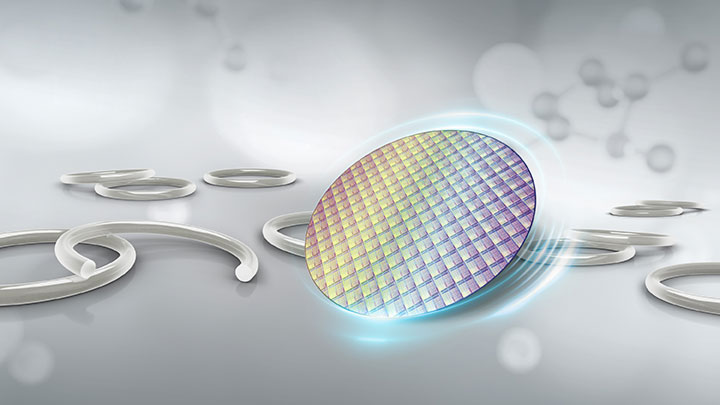In the high-tech field of semiconductor manufacturing, every step requires exceptional precision and cleanliness. Specialty rubber seals, as critical components that ensure stable operation of production equipment and maintain a highly clean production environment, have a direct impact on the yield and performance of semiconductor products. Today, we will delve into how specialty rubber seals such as fluororubber and perfluoroelastomer play a crucial role in semiconductor manufacturing.
I. The Stringent Requirements of Semiconductor Manufacturing Environments
Semiconductor manufacturing is typically conducted in cleanrooms, where environmental cleanliness requirements are extremely high. Even tiny particles of contaminants can cause chip short circuits or other performance defects. Furthermore, the manufacturing process involves the use of a variety of highly corrosive chemicals, such as photoresists, etching solutions, and cleaning fluids. Furthermore, some process steps experience significant temperature and pressure fluctuations. For example, etching and ion implantation processes generate high temperatures and pressures within the equipment. Furthermore, precipitates from seals can have a serious impact on semiconductor manufacturing. Even trace amounts of precipitates can contaminate semiconductor materials or processes, disrupting the accuracy of the production process.
II. The Key Roles of Specialty Rubber Seals
1. Preventing Particle Contamination: Specialty rubber seals effectively block dust, impurities, and other particles from the external environment from entering the equipment, maintaining a clean environment. Taking perfluoroelastomer seals as an example, their smooth surface resists particle absorption. Their excellent flexibility allows them to fit tightly to equipment components, forming a reliable sealing barrier and ensuring that the semiconductor manufacturing process is free from particle contamination.
2. Resisting Chemical Corrosion: Seals such as fluorocarbon and perfluoroelastomer offer excellent resistance to the chemical reagents commonly used in semiconductor manufacturing. Fluorocarbon seals are resistant to common acidic and alkaline solutions and organic solvents, while perfluoroelastomer seals are particularly stable in highly oxidizing and corrosive chemical environments. For example, in wet etching processes, perfluoroelastomer seals can withstand prolonged contact with highly acidic etching solutions without corrosion, ensuring the sealing and stability of the equipment.
3. Adapting to Temperature and Pressure Fluctuations: Semiconductor manufacturing equipment experiences frequent temperature and pressure fluctuations during operation. Specialty rubber seals require excellent high- and low-temperature resistance, as well as excellent elasticity and pressure resistance. Fluororubber seals maintain excellent elasticity and sealing properties within a certain temperature range, adapting to temperature fluctuations during different processing stages. Perfluoroelastomer seals, on the other hand, not only withstand high temperatures but also resist becoming hard or brittle at low temperatures, maintaining reliable sealing performance and ensuring the normal operation of equipment under various complex operating conditions.
4. Controlling the Risk of Precipitation: Controlling precipitation from seals is crucial in semiconductor manufacturing. Specialty rubber seals such as fluoroelastomer and perfluoroelastomer utilize optimized formulations and production processes to minimize the use of various additives, thereby reducing the likelihood of precipitation of impurities such as small organic molecules and metal ions during the manufacturing process. These low precipitation characteristics ensure that the seals do not become a potential source of contamination, maintaining the ultra-clean environment required for semiconductor manufacturing.
III. Performance Requirements and Selection Criteria for Specialty Rubber Seals
1. Cleanliness-Related Properties: Surface roughness, volatility, and particle release are key indicators of seals. Seals with low surface roughness are less prone to particle accumulation, while low volatility reduces the risk of organic gas emissions from seals in high-temperature environments. When selecting seals, prioritize products with special surface treatments that offer low volatility and particle emission. For example, plasma-treated perfluoroelastomer seals offer a smoother surface and effectively reduce volatility. Also, pay attention to the seal’s release properties and select products that have undergone rigorous release testing to ensure they emit no harmful emissions in semiconductor manufacturing environments.
2. Chemical compatibility: Select the appropriate rubber material based on the specific chemical reagents encountered during semiconductor manufacturing. Different types of fluoroelastomer and perfluoroelastomer have varying resistance to different chemicals. For processes involving strong oxidizing acids, highly oxidizing perfluoroelastomer seals must be selected. For processes involving general organic solvents, fluoroelastomer seals may be a more cost-effective option.
3. Physical properties: These include hardness, elastic modulus, and compression set. Seals with moderate hardness ensure a good seal while also facilitating installation and removal. Elastic modulus and compression set reflect the performance stability of a seal under long-term stress. In high-temperature and high-pressure environments, seals with minimal compression set should be selected to ensure long-term, stable sealing performance.
IV. Practical Application Case Analysis
A well-known semiconductor manufacturer was experiencing frequent corrosion and aging of conventional rubber seals in the etching equipment on its chip manufacturing line. This led to internal leaks, impacting production efficiency and significantly reducing chip yields due to particle contamination. Furthermore, the conventional seals released large amounts of organic impurities during the high-temperature process, contaminating the semiconductor material and causing unstable product performance. After replacing them with perfluoroelastomer seals manufactured by our company, the equipment’s operational stability improved significantly. After a year of continuous operational monitoring, the seals showed no signs of corrosion or aging, maintaining a highly clean interior, and increasing chip yields from 80% to over 95%. This was achieved thanks to the perfluoroelastomer seals’ excellent chemical resistance, low precipitation characteristics, and excellent physical properties, resulting in significant economic benefits for the company.
Conclusion: In the semiconductor manufacturing industry, which strives for extreme precision and cleanliness, specialty rubber seals play an indispensable role. Specialty rubber seals such as fluoropolymer and perfluoroelastomer, with their superior performance, including strict control over precipitation, provide reliable sealing for semiconductor manufacturing equipment, helping the industry continuously advance to higher technological levels.
Post time: Oct-17-2025

